Pentax K-3 III Review
Pentax K-3 III Ergonomics - How is it operated?
Pentax ergonomics are legendary and are virtually unchanged since the launch of the K-7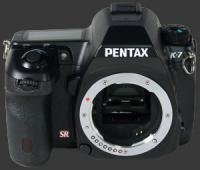
Pentax K-7 that introduced the narrow-body DSLR design 12 years ago. The Pentax K-3 III clearly follows the same mold yet makes several incremental improvements. This DSLR will be instantly familiar to current Pentax uses and requires a minimal adaptation period to develop new muscle-memory.
Although the majority of external controls operate in the same was as on the Pentax K-3 II, this review describes every control and usability aspect of the K-3 III to cover all subtle changes and fully present ergonomics to all potential buyers, regardless if they are familiar with Pentax cameras.
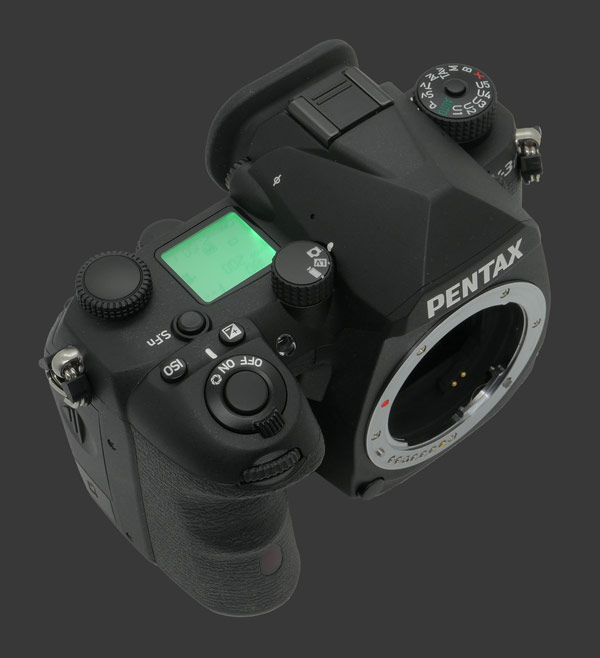
The Pentax K-3 III is designed with extreme precision to offers an exceptional number of physical controls in a fairly compact and very comfortable body. This DSLR feels really sturdy with an impressive density. Its deep hand-grip has a an extra-deep indentation and central protrusion for the most stable grip on any camera. This sculpted grip guides fingers diagonally so that the index-finger lands comfortably on the shutter-release and the thumb right along the rear control-dial and 8-way focus joystick, all described further down in this review page.
A redesigned two-stage shutter-release with short travel to a moderately soft halfway point gives a very nice response while minimizing chances of triggering it accidentally. The release is angled so that it gets pressed perpendicularly in a very natural movement. A classic Pentax 3-way rotating switch surrounds the shutter-release. There is a firm detent between the Off and On positions, while a spring automatically pulls back from the DOF position when released. By default, this is an optical preview that stops down the lens aperture but this can be switched to a Digital Preview function.
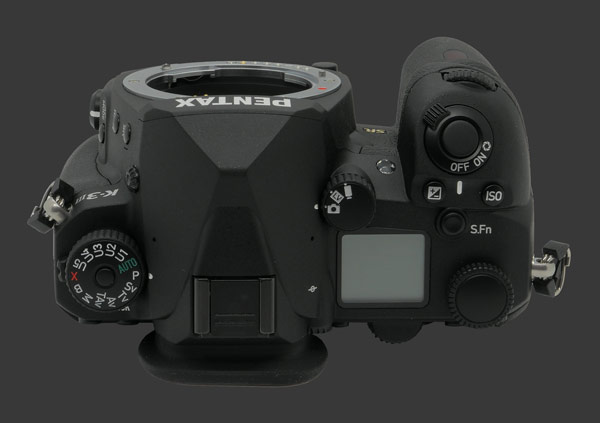
There are physical controls on every practical surface of the K-3 III. Its top plate is busier than previous flagship APS-C cameras. The narrow right shoulder fits a lockable Exposure Mode dial with 14 positions, as described in the first page of this review. Firm detents avoid accidental changes. To further secure the dial, a rotating which at the base of the Mode-Dial lifts a spring loaded button that must be held down to change Exposure Mode.
A wide viewfinder housing enclosed the newly enlarged OVF with 1.05X magnification and 100% coverage, leaving no room for a builtin GPS or popup flash. A stereo microphone has openings on both sides of the housing, while a standard Hot-Shoe sits on top. There are still Flash Modes on the K-3 III to precisely control and add-on unit: On, Redeye, Slow-Sync and Slow-Sync+Redeye. Flash Compensation can be set from -2 to +1 in 1/2 or 1/3 EV increments.
The right side of the top plate is more crowded than its predecessor due to the appearance of a third control-dial, similarly to on the K-1 and K-1 Mark II Full-Frame DSLRs. This forced Ricoh to shrink the top Status LCD which still shows a fair amount of information. Pentax cleverly uses the metering sensor to automatically illuminate this small display. Photographers can choose between two levels of backlight now. The Status LCD lights up with a pleasant green-glow as needed, keeping it perfectly visible in low-light.
Additional controls on the back of the camera pushed the capture mode switch to the top of the camera, resulting in the only awkwardly-located control on the camera. This small dial has three positions to change between Standard, Live-View and Video modes. Modes are cramped together along a quarter of the dial which has firm detents and is textured, similarly to the Mode-Dial, to ensure a good grip on it. Even though it disturbs the aesthetics of the camera, this is quite usable.
Above the hand-grip, just behind the combined shutter-release and power-switch, there are buttons for EC and ISO. This buttons are perfectly positioned to provide direct access to those two important exposure parameters. Technically the ISO button is redundant since the Pentax K-3 III is equipped with triple control-dials. For this reason, not making the ISO button programmable is a lost opportunity. One can customize dials through, so that could force users to reach for the ISO button, yet there is little reason to do so.
When Ricoh added the third control-dial to the K-1, they severely restricted its possible customization by adding a fourth dial to control the third! Now, the K-3 III greatly expands features of the third control-dial by making it customizable to control up to 5 functions. A newly added Smart Function (S.Fn) button right behind the EC button allows users to switch between features assigned to the top control-dial by rotating the rear control-dial. To assist users, changes to the top control-dial are shown in the OVF, Status LCD and rear LCD. Those shown in the viewfinder are hard to see in low-light though.
The third control-dial appears on the back-right corner of the top-plate. To avoid confusion, it will be referred to as top control-dial in this review. This dial has stronger detents than others to prevent unintentional changes. The outer edge of the top control-dial has a rubberized texture which is easily distinguishable by feel from the rear control-dial nearby. It can control any 5 of 22 functions: User AF, AF Mode, AF Area, AF Hold, Focus Peaking, Metering, E-Dial, ISO, EC, FC, Program-Line, White-Balance, Drive Mode, Anti-Alias Filter Simulation, HDR, Pixel-Shift, Crop, Color Mode, Shake Reduction, Review Zoom, Grid Overlay or Outdoor Viewing. This is truly an unprecedented amount of customization!
With the top control-dial set to E-Dial, its behavior can be controlled independently for every Exposure-Mode in both Photo and Video mode. Additionally, its rotation direction and Hyper-Program mode can be switched. When Hyper-Program is set to Standard, it behaves as on previous cameras, allowing shifting along aperture or shutter-speed values. When it set to Advanced, shifting all parameters automatically enters Manual exposure-mode. Although is a powerful feature, it needs much more careful attention to avoid exposure errors.
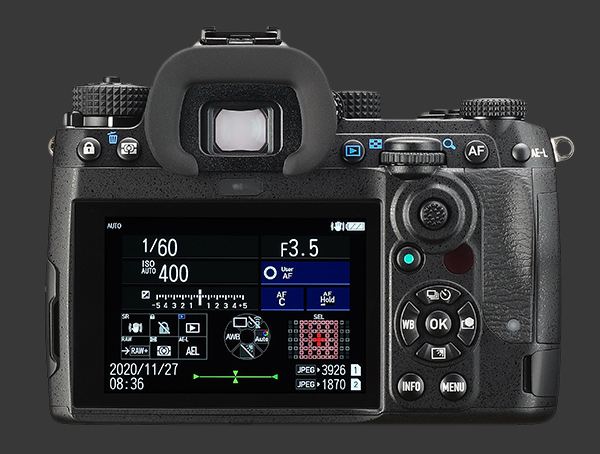
The narrow back of the Pentax K-3 III is truly dominated by a 3.2" Touchscreen LCD. This ultra-sharp display has 1.6 megapixels of resolution. Its fixed position and air gapless design make this DSLR exceptionally sturdy and quite slim. The display has a wide vertical angle-of-view and reasonable horizontal one. It offers a wide range of brightness and Outdoor View settings optionally boost the backlight to improve visibility. A converse Night View mode turns everything on the display red. It is quite jarring at first but said to help adapt to extremely poor lighting. Too bad there is no option to turn it a deep blue that would provide more neutral color-perception. The screen is somewhat reflective and highly prone to fingerprints, so adding a tempered glass protector with anti-glare coating is strongly recommended.
Around the rear LCD, the K-3 III packs tons of controls, leaving a narrow vertical strip available for the palm of the hand. The top two-thirds of that strip has a nice soft rubber-coating for comfort.. There are two customizable buttons above the top-left corner of the rear LCD. One defaults to Lock, the other to Metering. Ricoh has been trying to figure how the best assignment for these buttons for years, changing them between each generation. On the K-3 they were Play and Metering, on the K-5 series they were Play and Delete. For the first time, these buttons can be configured with a choice of 29 functions! There are many useful functions to choose from, none of which is Lock, since K-3 dials have firm detents.
Skipping over the optical viewfinder, one land onto a Playback button that can be customized too. This makes it possible to restore the layout from preview generations. Those who often review images might prefer to assign Playback to the leftmost button, so that it is next to Delete. The default position of Playback is a little cramped but usable. The importance is to make sure at least one button is assigned to Playback.
Immediately to the right of Playback, one finds the rear control-dial that protrudes nicely from the back of the camera and has good detents. Further right, there are two more customizable buttons that default to AF-On and AE-L. The former is customizable along with the action of the shutter-release, while the latter has access to the same 29 features as Lock, Metering and Playback. The behavior of the AF button can be set differently in Photo and Video mode. AE-L is smaller than other buttons but Ricoh made it protrude more to make it distinguishable.
Controls crowd the right side of the rear LCD from top to bottom. Topmost, an 8-way joystick makes its debut on the Pentax K-3 III along with the new 101-Point SAFOX XIII autofocus system. The joystick has a nice response and is clickable to center focus. Note that the joystick works even in MF mode since the selection is used for MF-Assist mode. The joystick protrudes nicely and has a rough texture for extra grip. This well-placed controls is underused and does very little other than select focus.
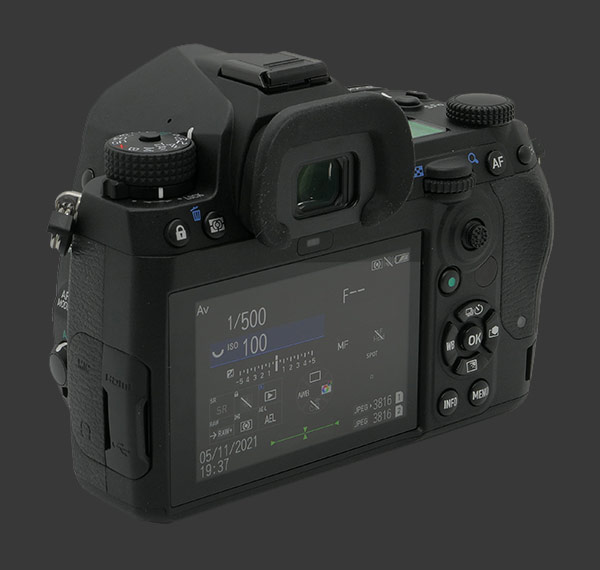
A Pentax staple, the Green button, is found below the 8-way joystick. This button serves to reset settings various settings. In P, M and TAv mode it resets the exposure to the program line by default. In other modes it automatically sets the ISO sensitivity. When used in conjunction with the EC button, it resets the applied EC value, perfect for preparing for the next shot. It resets White-Balance fine tuning from the WB setting screen as well. It resets AF-Fine-Tuning adjustments too when calibrating lenses.
Continuing down, there is a cluster of 5 buttons that form a 4-way controller with central OK button. Each cardinal direction can be assigned a function with defaults, clockwise starting from the top: Combined Drive and Timer, Color Mode, Outdoor View and White-Balance. One change from earlier DSLRs is that these buttons remain active during Instant View. This makes them behave differently than in Playback mode.
The last two buttons on the camera are Info and Menu. While the latter works exactly as expected, the Info is different now. Instead of cycling over display modes, this button jumps into a grid of 20 icons. Each icon can be configured to one an outstanding 44 functions! This iconic menu works in a very strict way: The 4-way controller must be used to select an icon while the rear control-dial is the only one that can change a setting. This puts a huge amount of features nearly but would have been much better if the joystick could be used to select an icon. As is, the mode of operation is slower since the thumb must constantly shift between the rear control-dial and 4-way controller. Even if the front control-dial could change settings, this would have improved handling.
The Pentax K-3 III viewfinder shows 100% coverage at 1.05X magnification which makes it larger than any OVF on a cropped-sensor DSLR. This difference is noticeable yet not substantial. The framing experience is more comfortable and helps confirm focus. A green LCD line below the view shows exposure parameters very clearly. It also shows the Drive Mode and state of Shake Reduction. A new LCD overlay layer inside the viewfinder adds focus-points, a dual-axis digital-level, framing guides and top control-dial settings. This layer is unfortunately rather dim and really difficult to see in low-light. It optionally gets illuminated for a very short fraction of a second when the shutter-release is pressed halfway. This helps a tiny bit but leaves room for improvement.
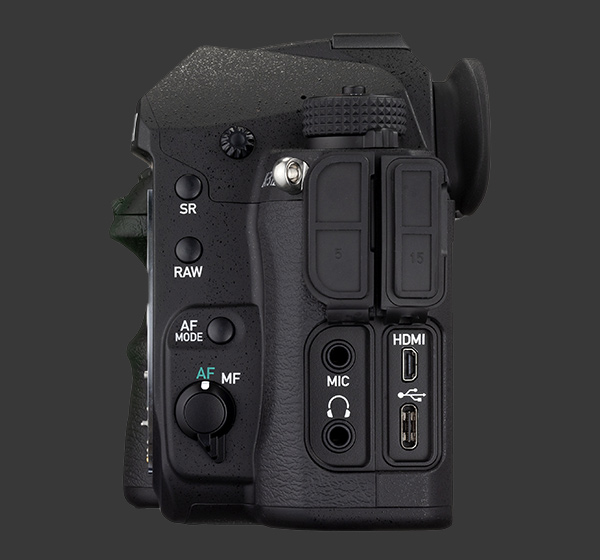
As a modern DSLR, this one supports Live-View shooting. In this mode, framing is done via the rear LCD, while the camera uses the imaging-sensor to generate a preview. Theoretically, this allows a DSLR to show an accurate preview of exposure. Sadly, this is not the case with the K-3 III, even with the Exposure Simulation Live-View option enabled. This setting only corrects the preview in Manual mode but that means that exposure issues cannot be noticed in other modes until after the photo is taken. For some reason, Ricoh made the histogram minuscule which makes it hard to spot minor clipping.
Pentax DSLRs used to have a column of buttons to the left of the LCD screen but these disappeared to make the K-7 slimmer than the K20D that precedes it. Buttons eventually appeared on the left-side of the camera. There, the Pentax K-3 III sports an AF/MF Switch, AF Mode button, RAW button, SR button and a Sync-Port. The higher two buttons are configurable, while AF enables the front and rear control-dials to change AF Drive and AF Selection, respectively. The top control-dial keeps its assigned function and AF Mode is pressed.
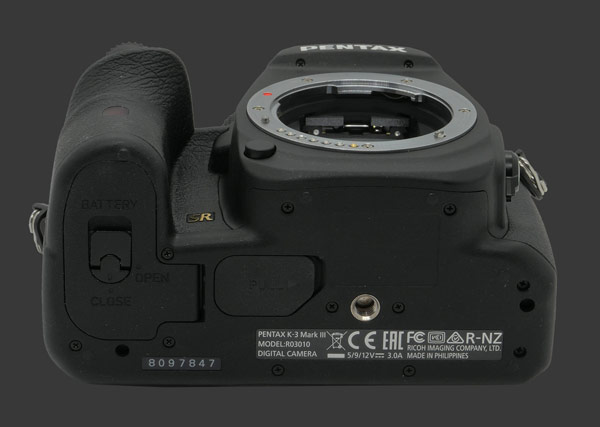
The grip side of the camera has a sturdy slighting door that covers a pair of SDXC memory card slots. Each slot is clearly labeled with its number. Ideally, there would be a UHS-II symbol next to the first slot. A soft rubber pad makes the memory-card compartment weatherproof. The bottom of the camera has a metal tripod mount aligned with the optical axis which is ideal for panoramic photography. A solid door covers the battery compartment and is sealed with a latch to keep it closed tightly. The battery door is sufficiently far to change batteries while the camera is attached a large quick-release plate.
Pentax K-3 III Usability - How easy is it to use?
The Pentax K-3 III provides physical controls to directly access every important function. With its combination of triple control-dials, joystick and numerous buttons, it can easily be configured into the most efficient digital camera yet! Its triple control-dials are highly customizable and key to maximizing efficiency.
Control-Dials and the Green button can be configured independently for 8 Exposure-Modes: P, Sv, Tv, Av, TAv, M, B and X in Photo mode and 5 in Video mode: P, Av, Tv, TAv, M. Front and rear control-dials can set any exposure-parameter available for the chosen exposure-mode, except ISO in M and Bulb modes. Since there is a dedicated ISO button, one can assign extra any dial to Program Shift, Aperture Shift, Shutter-Speed Shift or Exposure-Compensation, when applicable to the Exposure-Mode. The Green button can reset the Program-Line, ISO or EC. This outstanding amount of flexibility is extremely useful!
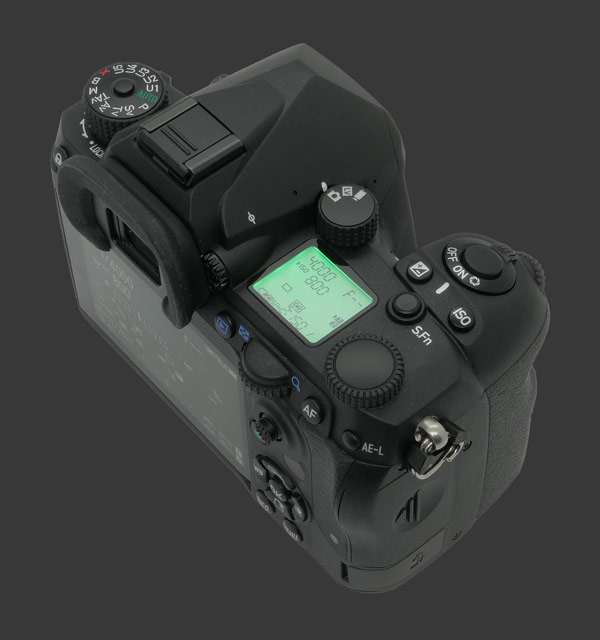
The dedicated EC button adds to those triple control-dials so that exposure can be completely controlled with the camera at eye-level. Focusing time can be split between the shutter-release and rear AF button for those that prefer fixing the focus distance over multiple frames. The 8-way joystick is easily reachable to select where to focus. Focus Drive and Selection are also highly efficient to change by moving the thumb of the hand holding the lens back to press the AF Mode button. Then, use front and rear control-dials to change focus settings.
One can change Drive Mode in several ways. By default, the Up button invokes a two level menu that splits the actual drive from triggering options. These are completely independent which is why Ricoh separated them. For photographers that frequently change drive modes, the K-3 III can configure buttons to access either half of those drive options independently. One button can bring up the list of triggers: Instant, 3s Remote, Immediate Remote, 2s Self-Timer and 12s Self-Timer. Another the list Drive Modes: Single, High-Speed Continuous, Medium-Speed Continuous, Low-Speed Continuous, AEB, Aperture Bracketing, Shutter-Speed Bracketing, Mirror Lock-Up, Multiple-Exposure, Interval-Time and Interval-Composite. Note that this list is dynamic and automatically hides non-applicable options.
There are two features that conflict with drive modes without hiding them from the list: HDR and Pixel-Shift. When those are selected, the Drive Mode is implied. Changing Drive Mode while HDR or Pixel-Shift is enabled, simply turns off the feature. It would have been simpler to place those in the list but this is a very minor point.
The high number of physical controls on the Pentax K-3 III leave little reason to enter the menu system during photography. This is great because, while camera usability is amazing, the menu system can only be described as a disaster. Navigating the menu itself is intuitive but finding specific settings is tedious due to a convoluted layout with very poor organization. The menu shows 4 top-level tabs long the left edge, each represented by an icon: Photo/Video, Playback, Customization and Settings. The topmost tab is Photo in standard Photo or Live-View mode and Video otherwise. Its content changes partly depending on the capture mode.
Each top-level menu is divided into 7 or 8 loosely defined pages. A page can have 2 to 7 entries. When there are fewer than 7, the page still shows 7 entries by including extra ones from the next page. Last pages fill the opposite way, showing their entries at the bottom, preceded by entries from the previous page. Adding to this mess, organization is unintuitive which makes locating a particular setting quite tedious. The conceptual division between Customization and Settings is not very clear either. Another cause of confusion is that many menu items disappear or become disabled due to another setting with no explanation provided.
To avoid having to frequently enter this menu maze, Ricoh switched the interactive status display of previous models with a 5x4 icon-grid. Each icon is completely customizable, allowing access to 20 features while avoiding the menu system. The Info button is used to bring up and close those settings. Note that the K-3 does not have a Disp button like the many cameras and so there is no way to cycle over various display modes, except during playback, where Info serves this purpose.
There are actually plenty of very flexible Display Modes on the Pentax K-3 III. For Live-View, up to 3 modes can be configured with a Histogram, Grid, Flashing Highlights and a customizable Electronic Level. This level can show a horizontal and vertical axis or just the horizontal. It can be represented in 3 ways. Playback mode always has two display modes, each customizable with the same options as the Live-View display, except for the Electronic-Level. The new OVF design allows it to offer 4 Display Modes. Each is customizable with a Grid, Dual-Axis Level, AF Frame, Spot Metering Circle, AF Points and the chosen top control-dial function. To change OVF modes, an icon in the Info grid must be assigned to control this. Among this astonishing number of Display Modes, a large histogram is missing, making it more difficult to notice clipping.
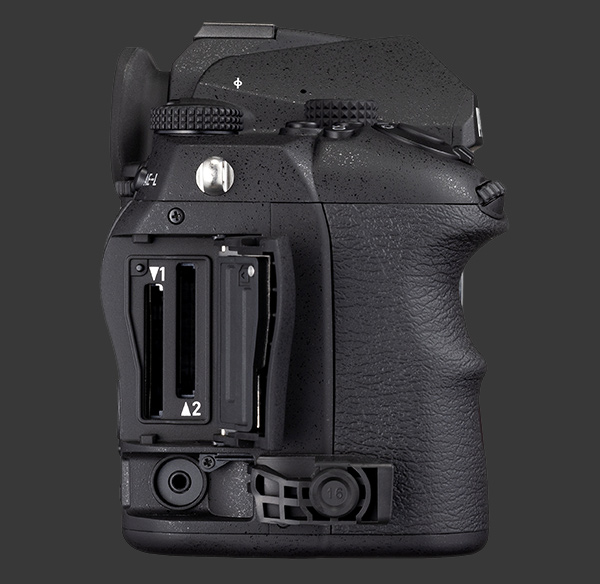
An extremely useful feature of Pentax cameras is their customizable memory. The K-3 III supports: ISO, EC, Flash Mode, FC, WB, Drive, Timer/Remote, HDR, Pixel-Shift, Crop, Color Mode, Digital Filter, Clarity, Skin Tone, Composition Adjustment, Shooting Display, Playback Display, Playback Image, Lock, Outdoor View Setting, and Night Vision. Any of these settings can be reset each time the camera is powered off, as selected by the user. This thoughtful feature minimizes mistakes when starting a photo session.
Previous Pentax DSLR cameras always automatically disabled Shake-Reduction when a Self-Timer or Remote-Trigger is enabled. This is extremely helpful since it is the correct thing to do nearly all the time. Some third-party lenses attempt to detect a tripod which is not 100% reliable. The Pentax method is much more effective but the K-3 III adds an option to turn off this behavior.
Usability of the Pentax K-3 III is truly class-leading. With a few enhancements, this camera even manages to surpass the usability of its predecessors, mostly due to the third control-dial and added 8-way focus joystick. As mentioned earlier, there are a small number of cases where a little efficiency was lost but overall this is the most efficient digital camera on the market. It makes an outstanding amount of features highly accessible while providing plenty that help the photographer work faster and avoid common mistakes.
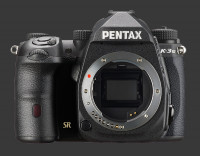 |
Please Support Neocamera
All information on Neocamera is provided free of charge yet running this website is a huge endeavor. Purchases made via affiliate links found throughout the site help keep it running and up-to-date. There is no additional cost to you, so please consider buying via these links to our affilates:
If you found any information on this site valuable and did not purchase via our affiliate links, please considering donating via PayPal:
Any amount will be greatly appreaciated. Thank you for your support!
Pentax K-3 III Highlights

Sensor-Size: 24 x 16mm

Actual size when viewed at 100 DPI
| 26 Megapixels DSLR | ISO 100-1600000 |
| Pentax K Mount 1.5X FLM | Shutter 1/8000-1200s |
| 5-Axis Built-in Stabilization, 5.5-Stop Improvement | Full manual controls, including Manual Focus |
| 100% Coverage Extra Large Viewfinder | Custom white-balance with 2 axis fine-tuning |
| Automatic Eye-Start sensor | Spot-Metering |
| Auto Horizon Correction 2 Axis Digital Level | Hot-Shoe & Sync-Port |
| Weatherproof down to -10C | Stereo audio input |
| Built-in Dust Reduction | Lithium-Ion Battery |
| 12 FPS Drive, 37 Images | Secure Digital Extended Capacity x 2 |
| 3840x2160 @ 30 FPS Video Recording | |
| 3.2" LCD 1.6 Megapixels |
Updates
2024.04.03

Fujifilm X-T5 Review
Newest Fujifilm flagship boasting a 40 MP APS-C sensor, 5-axis IBIS with 7-stop efficiency, 15 FPS continuous drive, 6.2K Video capture, dual control-dials and dual SDXC UHS-II slots in a sturdy weatherproof and freezeproof body.
2023.11.20

Best Digital Cameras of 2023
Find out which are the Best Digital Cameras of 2023. All the new Mirrorless Digital Cameras from entry-level to high-end professional.
2023.07.10

Fujifilm X-H2 Review
40 Megapixels APS-C Hybrid Mirrorless Digital Camera with 7-stop IBIS. Fastest shutter ever and 8K video capture. Large builtin EVF with 0.8X magnification and 5.8 MP, plus an Eye-Start Sensor. Packed with features and large number of controls in a weatherproof and freezeproof body.
2023.05.07

Sony FE 20-70mm F/4G Review
Review of the unique Sony FE 20-70mm F/4G lens. The optical zoom of this lens spans ultra-wide-angle and medium focal-length coverage, making it one of the most versatile Full-Frame lenses on the market.
2023.01.15

Huion Inspiroy Dial 2 Review
Review of the Huion Inspiroy Dial 2 tablet, a medium sized drawing surface with dual dials and customizable buttons. Connects via USB-C or Bluetooth 5.0 with Windows, Linux and Android support.
2022.12.08

How to Pack for a Photo Trip
Find out how to pack for a travel photography trip, carry your gear safely while meeting airline regulations.
2022.11.13

Best Digital Cameras of 2022
The best digital cameras of 2022. A short list of the most outstanding models in their respective categories. Choose one for yourself or as a gift.
2022.09.21

Pentax DA* 60-250mm F/4 SDM Review
Review of the Pentax DA* 60-250mm F/4 SDM, the constant-aperture telephoto zoom with the highest zoom-ratio on the market.
2022.09.20

Pentax DA* 50-135mm F/2.8 SDM Review
Review of the Pentax DA* 50-135mm F/2.8 SDM, the lightest professional telephoto zoom native to the K-mount.
2022.09.10

Pentax DA* 11-18mm F/2.8 DC AW Review
Review of the Pentax DA* 11-18mm F/2.8 DC AW, the widest professional ultra-wide zoom native to the K-mount.
2021.11.24

50 Gifts Under $50 For Photographers in 2021
50 Gifts photographers will love. All for under $50 USD. 2021 Edition.
2021.11.17

Best Digital Cameras for 2021
Neocamera shows which are the very best Digital Cameras for 2021 in every category: Mirrorless, DSLR, Premium Compact, Ultra-Zoom and Rugged.











